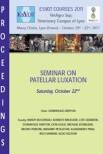Feline stifle osteoarthritis (OA) is common, however little is known about the early stages of the disease. Furthermore, the importance of small articular mineralizations (AMs) in feline stifle OA is controversial. This study aimed to describe microscopic articular cartilage lesions and to investigate associations between cartilage lesions and AMs, synovitis, osteochondral junction findings and subchondral bone sclerosis.
Stifles of 29 cats, aged 1-23years and euthanized for reasons other than stifle disease, were examined. Osteochondral tissue and synovial membrane changes were histologically evaluated. Computed tomography and radiography were used for evaluation of AMs. Global cartilage scores (GCS, n=28) were summarized and joints assigned a histologic OA grade.
Minimal to mild histologic OA was seen in 24/28 joints. In 27/29 joints tibial cartilage lesions were seen, whereas femoral lesions were only seen in two joints. Articular mineralizations were detected in 13/29 joints, 11 were small and 12 were located entirely within the medial meniscus. There was no association between GCS and presence or volumes of AMs. However, higher GCS was associated with synovitis (P=0.001) and age (P<0.0005). Presence of subchondral bone sclerosis (P<0.0005) and disruption of the calcified cartilage or tidemark (P<0.0005) were associated with cartilage lesions.
We conclude that the tibial articular cartilage is a common location for histologic OA lesions in cats. Synovitis and changes in the subchondral bone and calcified cartilage may be important in the pathogenesis of feline stifle OA, whereas small AMs likely represent incidental findings.
Cartilage lesions in feline stifle joints - Associations with articular mineralizations and implications for osteoarthritis
Journal
Leijon A, Ley CJ, Corin A, Ley C. Res Vet Sci. 2017 Apr 19; 114: 186-193.









